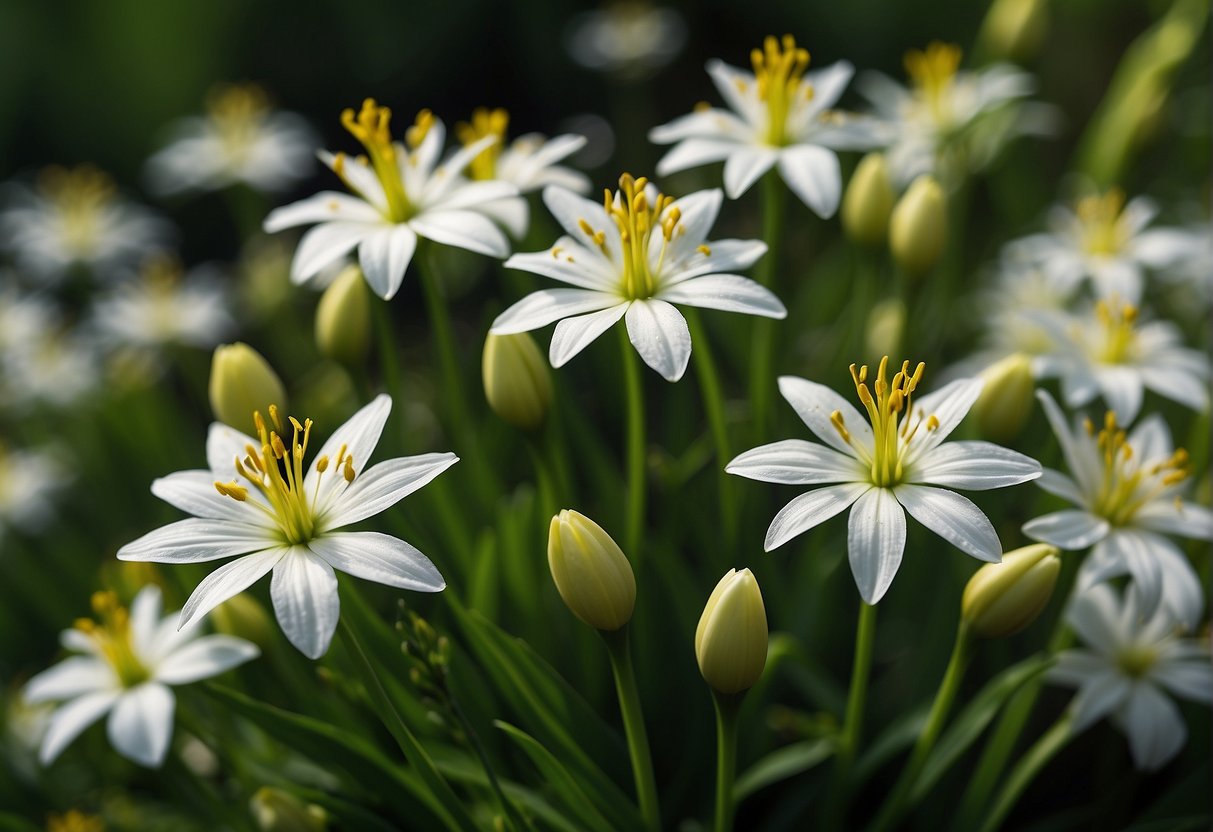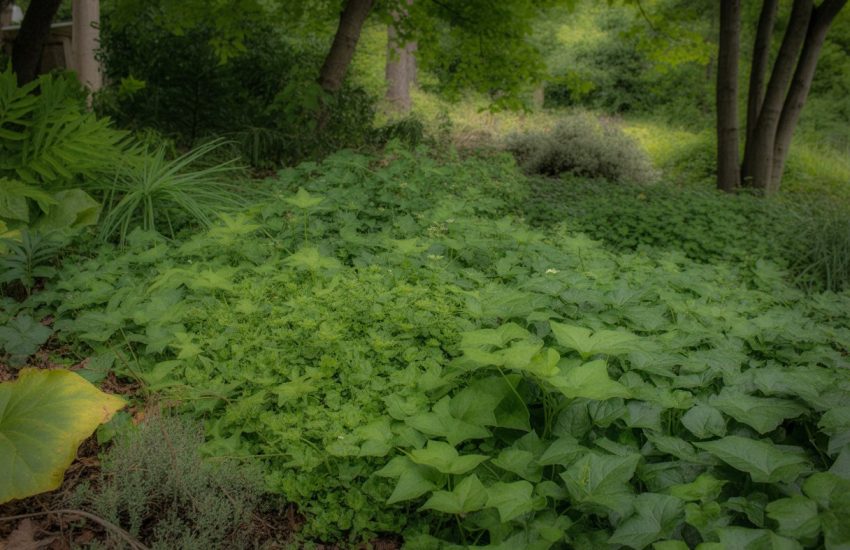Star of Bethlehem Flowers: Characteristics and Growing Tips
Star of Bethlehem flowers, also known as Ornithogalum umbellatum, are a beautiful and unique addition to any garden or floral arrangement. These perennial plants are native to Europe, but can now be found growing in many parts of the world. The name “Star of Bethlehem” comes from the shape of the flowers, which resemble a star with six pointed petals.

One of the most striking features of the Star of Bethlehem flower is its pure white color. The petals are long and narrow, and the flower itself can grow up to 12 inches tall. In addition to their beauty, these flowers are also known for their sweet fragrance, which can fill a room or garden with a delightful scent.
Star of Bethlehem flowers have been used for a variety of purposes throughout history. In traditional medicine, the bulbs of the plant were used to treat a range of ailments, including respiratory issues and digestive problems. Today, the flowers are primarily used for ornamental purposes, but their historical significance and medicinal properties make them a fascinating topic for further exploration.
Understanding Star of Bethlehem

Star of Bethlehem, also known as Ornithogalum umbellatum, is a beautiful flowering plant that belongs to the Asparagaceae family. It is a perennial herb that grows from a bulb and produces delicate white flowers with a green stripe down the center.
Botanical Profile
The star of Bethlehem plant typically grows to a height of 12-18 inches and spreads to a width of 6-12 inches. The flowers bloom in the spring and have a sweet fragrance that attracts bees and other pollinators. The plant requires full sun to partial shade and well-draining soil to thrive.
Cultural Significance
The star of Bethlehem flower has a rich cultural significance in many parts of the world. It is believed to symbolize purity, innocence, and hope. In Christianity, the flower is associated with the birth of Jesus Christ and is often used as a decoration during Christmas.
The common name of the plant is derived from the star-shaped appearance of its flowers. It is also known by other common names such as nap-at-noon, eleven-o’clock lady, and snowdrop. The plant is native to Europe and has been naturalized in many other parts of the world.
In conclusion, the star of Bethlehem is a beautiful and culturally significant plant that adds a touch of elegance to any garden. Its delicate flowers and sweet fragrance make it a popular choice for both indoor and outdoor decoration.
Planting and Growing Conditions
Soil Preferences
Star of Bethlehem flowers thrive in well-draining soil that is rich in organic matter. They prefer a slightly acidic soil with a pH level between 6.0 and 7.5. If the soil is too alkaline, the flowers may not grow well. It is best to amend the soil with compost or peat moss before planting to improve the soil quality.
Light Requirements
Star of Bethlehem flowers prefer full sun to partial shade. They can tolerate some shade, but they will not bloom as well. The flowers require at least six hours of direct sunlight per day to grow and bloom properly.
Planting Tips
Star of Bethlehem flowers can be planted in the spring or summer. They can be grown from bulbs or seeds. If planting bulbs, they should be planted in the fall for spring blooms. When planting, the bulbs should be planted 2-3 inches deep and spaced 3-4 inches apart.
If planting in the summer, seeds can be sown directly into the soil. The soil should be kept moist until the seeds germinate.
Star of Bethlehem flowers are hardy in USDA zone 3 and above. They can tolerate cold temperatures and are drought-tolerant once established. It is important to note that the flowers can become invasive if not managed properly. It is recommended to deadhead the flowers after blooming to prevent self-seeding.
In summary, planting and growing Star of Bethlehem flowers is relatively easy as long as the soil is well-draining and they receive enough sunlight. With proper care, these flowers can add a beautiful touch to any garden.
Care and Maintenance
Star of Bethlehem flowers are relatively easy to care for and maintain. With proper care, they can bloom beautifully year after year. In this section, we will cover some essential care and maintenance tips for these lovely flowers.
Watering and Fertilizing
Star of Bethlehem flowers prefer well-drained soil and moderate watering. They do not require frequent watering, and overwatering can cause root rot. It is best to water them deeply once a week, especially during hot and dry weather.
Fertilizing is not necessary for these flowers, but it can help promote healthy growth and blooming. It is recommended to use a balanced fertilizer once a month during the growing season. Be careful not to over-fertilize, as it can lead to excessive foliage growth and fewer blooms.
Pruning and Deadheading
Pruning and deadheading are essential to keep star of Bethlehem flowers healthy and blooming. Deadheading, which is the removal of spent blooms, encourages the plant to produce more flowers. It is best to deadhead regularly during the blooming season.
Pruning should be done in early spring before new growth appears. It is recommended to cut back the stems to about 6 inches above the ground. This will help promote healthy growth and blooming.
Overwintering and Propagation
Star of Bethlehem flowers are hardy and can survive winter in most regions. However, they may benefit from a layer of mulch to protect the roots from freezing temperatures.
Propagation can be done by dividing the bulbs in early spring or fall. It is best to divide them every three to four years to promote healthy growth and blooming.
In summary, star of Bethlehem flowers are relatively low maintenance and easy to care for. With proper watering, fertilizing, pruning, and deadheading, they can bloom beautifully year after year.
Potential Challenges

Star of Bethlehem flowers may present a few potential challenges to gardeners and landscapers. These challenges include their invasive nature, susceptibility to pests and diseases, and toxicity concerns.
Invasive Nature and Control
Star of Bethlehem flowers can be invasive and form dense clumps that can crowd out other plants. They can also spread rapidly through self-seeding and bulb offsets. To control their spread, gardeners should remove any seedlings and bulb offsets as soon as they appear. Hand-pulling or digging up the plants can also be effective, but care must be taken to remove all bulbs and bulb fragments to prevent regrowth.
Pests and Diseases
Star of Bethlehem flowers are susceptible to a few pests and diseases, including spider mites, aphids, and fungal diseases such as leaf spot and root rot. To prevent infestations, gardeners should keep the plants healthy and well-watered, and remove any infected plant material. In severe cases, chemical control may be necessary, but gardeners should always follow label instructions and use pesticides responsibly.
Toxicity Concerns
Star of Bethlehem flowers contain cardenolides, which are toxic to humans and animals if ingested. They can cause symptoms such as nausea, vomiting, and diarrhea, and in severe cases, cardiac arrest. Gardeners should always wear gloves when handling the plants and bulbs, and avoid planting them in areas where children or pets may come into contact with them. If ingested, seek medical attention immediately.
In summary, while star of Bethlehem flowers can be a beautiful addition to a garden or landscape, they do present a few potential challenges. Gardeners should be aware of their invasive nature, susceptibility to pests and diseases, and toxicity concerns, and take appropriate measures to control their spread and protect themselves and others.
Star of Bethlehem in Landscape Design

Star of Bethlehem (Ornithogalum) is a beautiful plant that can add a touch of elegance to any landscape design. This plant is known for its star-shaped flowers, which are usually white in color. It can be used in a variety of ways, including in gardens, containers, and as a companion plant.
Garden and Container Use
Star of Bethlehem is a versatile plant that can be used in both gardens and containers. In gardens, it can be planted in partial shade or full sun depending on the climate. It is also suitable for pots and containers, making it a great choice for those who have limited space.
When planting Star of Bethlehem in a garden, it is important to ensure that the soil is well-drained. The plant prefers moist soil, but it can be prone to root rot if the soil is too wet. It is also important to provide the plant with adequate sunlight to ensure that it blooms properly.
Companion Planting
Star of Bethlehem can also be used as a companion plant. It is known to attract beneficial insects, such as bees and butterflies, which can help to pollinate other plants in the garden. Additionally, it can help to deter pests, such as aphids, from other plants in the garden.
When using Star of Bethlehem as a companion plant, it is important to ensure that it is planted near other plants that have similar light and moisture requirements. This will help to ensure that all of the plants in the garden thrive.
In conclusion, Star of Bethlehem is a beautiful plant that can be used in a variety of ways in landscape design. Whether it is planted in a garden or used as a companion plant, it is sure to add a touch of elegance to any outdoor space.
Frequently Asked Questions

Are Star of Bethlehem flowers toxic to humans and pets?
Yes, Star of Bethlehem flowers are toxic to humans and pets. They contain lycorine, a toxic alkaloid that can cause vomiting, diarrhea, and even seizures. It is important to keep these flowers out of reach of children and pets.
What is the symbolism behind Star of Bethlehem flowers?
Star of Bethlehem flowers are often associated with purity, innocence, and hope. They are frequently used in religious ceremonies and are said to represent the Star of Bethlehem that guided the three wise men to the birthplace of Jesus.
Can you eat Star of Bethlehem flowers, and are they safe for consumption?
No, Star of Bethlehem flowers are not safe for consumption. As mentioned earlier, they contain lycorine, which can be toxic if ingested.
How can you differentiate Star of Bethlehem flowers from similar species?
Star of Bethlehem flowers are characterized by their six white petals and bright yellow stamens. They are also known for their distinctive star-like shape, which is where they get their name. It is important to note that there are several other species that resemble Star of Bethlehem flowers, so it is best to consult a field guide or expert if you are unsure.
What are the best practices for growing and caring for Star of Bethlehem flowers?
Star of Bethlehem flowers prefer well-drained soil and full sun to partial shade environments. They are relatively low-maintenance and do not require much watering or fertilization. However, they can be invasive and should be monitored closely if planted in a garden.
Do Star of Bethlehem flowers prefer full sun, partial shade, or full shade environments?
Star of Bethlehem flowers prefer full sun to partial shade environments. They can tolerate some shade, but too much shade can cause them to become leggy and weak. It is best to plant them in a location that receives at least six hours of direct sunlight per day.


